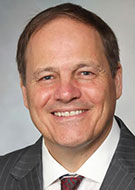Experts Publish Consensus on CT for Prosthetic Heart Valve Assessment
Multi-society group offers guidance for performing, interpreting, reporting cardiac CT for PHV


Experts from multiple medical societies have published a consensus document to provide guidance on how best to use cardiac CT for prosthetic heart valve (PHV) assessment. The consensus document was jointly published today in Radiology: Cardiothoracic Imaging.
“This expert consensus reflects a landmark collaboration among radiologists, cardiologists and cardiac surgeons to standardize the use of cardiac CT in evaluating prosthetic heart valve dysfunction,” said Radiology: Cardiothoracic Imaging editor and consensus document co-author Suhny Abbara, MD, senior associate consultant and chair, Division of Cardiothoracic Imaging in the Department of Radiology at Mayo Clinic, Jacksonville, FL. “With major advances in valve technologies, surgical techniques, CT imaging and clinical evidence over the past two decades, this document offers practical, evidence-based guidance to standardize utilization and to improve diagnostic accuracy, reporting consistency and patient outcomes.”
PHVs are biological or mechanical devices that are implanted in the body to replace damaged or diseased heart valves and improve blood flow. Like any implanted device, complications can occur with PHV implantation, including obstruction, (para)valvular leakage, structural valve deterioration and endocarditis.
Determining the root cause of PHV dysfunction is vital to identify the correct treatment strategy, which differs among patients.
The consensus document, co-authored by representatives of RSNA, the American College of Cardiology, the European Society of Cardiovascular Radiology, the North American Society for Cardiovascular Imaging, the Society for Cardiovascular Angiography & Interventions, the Society of Cardiovascular Computed Tomography and the Society of Thoracic Surgeons, provides a brief overview of heart valve replacement techniques and available imaging techniques for PHV assessment.
The authors—comprised of radiologists, cardiologists and surgeons—also provide a detailed description of the role of cardiac CT in cases of PHV dysfunction.
“The document provides consensus statements by a group of international experts on how to perform, interpret and report cardiac CT scans performed for PHV assessment, based on best practices from the available literature and the expert experience,” said lead author Ricardo Budde, MD, PhD, professor and principal investigator of cardiovascular imaging (CT) in the Department of Radiology & Nuclear Medicine at Erasmus Medical Center in Rotterdam, Netherlands.
Tailoring Acquisition to the Individual
While the experts agree that echocardiography remains an excellent first-line imaging tool for PHV assessment, they also assert that cardiac CT may provide complementary information to assess PHV function and help determine the cause of dysfunction.
Almost all PHV types can be adequately assessed both dynamically and statically with CT using dedicated viewing software to optimize the viewing planes. The experts advise that CT acquisition protocols should be tailored to the individual patient, considering the type and location of the PHV.
The document also includes consensus statements for correct indications and patient selection for CT assessment of PHVs, image acquisition, reconstruction and measurement protocols and how to interpret and report the CT findings for specific types of PHV dysfunction.